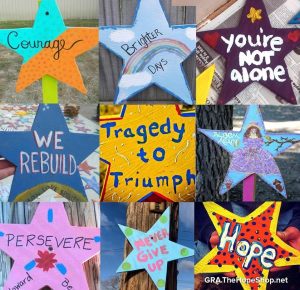When disaster strikes—particularly close to home—often the first people we hear from are our employees wanting to know what they can do to help as they seek the shared experience of grieving. Often, it is a challenge to provide the right tools and resources in the workplace. “Stars of HOPE” is one solution. The program provides an outlet for people—including employees—to provide support through the painting of inspirational words, messages, and designs on one-foot wooden stars for the victims. This helps to heal the deep emotional wounds of survivors while strengthening communities around the world recovering from tragedy through art, compassion, and connectivity.
Stars of HOPE was started by New York Says Thank You, an organization that was founded in response to 9/11 that uses the pay-it-forward concept to send volunteers from the city across the country to help those in need after a disaster, as a thank you for what those across the country did for New York. Thirteen years ago, executive director Jeff Parness founded New York Says Thank You at the urging of his five-year-old son. I recently had an opportunity to sit down with Jeff. He talked about how the group’s work, and that of hope, accelerates the healing process for disaster survivors.
New research from New York Says Thank You shows that giving a star in the “numbness phase” of an adapted Kubler Ross Change Curve, which tracks the stages of grief, takes people to the “New Relationships Phase” and then to the “Helping Others Phase,” bypassing many other stages. Also, Scott Allison, Professor of Psychology at the University of Richmond, said: “The Stars of HOPE program utilizes the latest scientific findings in positive psychology and heroism science to bring healing, growth, and resiliency to a world thirsty for loving kindness.” We have long known anecdotally that a hug, offering a hand, and other forms of comfort and support are helpful during troubling times, but it is nice to be able to substantiate this.
Stars in the face of terrorism
Although most stars are given to victims of natural disasters, recent terrorist attacks and other human-caused tragedies have resulted in an outpouring of support. A year ago this month, the deadliest home-grown terror attack to hit the U.S. since 9/11 happened in San Bernardino, California. Six months ago there was the senseless killing of 49 people at the Pulse Nightclub in Orlando, Florida. We have seen senseless acts of violence all over the world.
Employees at the Loews Hotels at Universal Orlando responded to their community with more than 1,000 employees painting stars after the Pulse Nightclub shooting. Then, they chartered a bus and went through the community, hanging the stars and giving them to people who were directly impacted, including families and friends of victims, and survivors.
We often forget the impact disasters have on the lives of first responders and care givers. Through Stars of HOPE, Loews employees also gave stars to trauma surgeons and nurses, 911 call operators, firefighters and police officers, and the staff at the Orlando lesbian, gay, bisexual, transgender and queer (LGBTQ) center. Explaining the importance of this effort, Loews’ PR director said these powerful words: “Goodness will always triumph over evil and we will forever be #OrlandoStrong.”
People who have received stars are paying it forward by sending them to others in the spirit of solidarity. In this clip, a victim from San Bernardino paints a star for Orlando.
Providing an outlet for employees and families
Employees of companies around the world and their families have sent a Star of HOPE to support others. Examples include:
- Children at KPMG’s “Take your Children to Work Day” painted stars for Syrian and Iraqi children. The stars were then distributed to refugee camps by volunteers from global law firm Dentons and the Saudi Red Crescent, a humanitarian society.
- Following the Brussels terror attack, JetBlue employees painted stars during Respectful Workplace Week to lift the spirits of the people of Belgium.
In addition, some companies are now buying Boxes of Hope kits that include 15 Stars, paint, and paint brushes to keep on hand for when needed. Parness told me: “The Stars of HOPE Box of HOPE program offers corporate volunteers a unique in-office, hands-on disaster relief volunteer opportunity that can make a direct impact on the emotional recovery and resiliency of disaster survivors in both the immediate and long-term aftermath of both natural and man-made disasters.” To date, more than 50,000 volunteers from 112 communities in 20 countries have participated in the program.
Stars are an important symbol. During this holiday season, we often see a star at the top of a festively decorated tree. Hope gives people the drive to move forward. The stars can be one way to facilitate employees’ compassion and channel it directly to those who need hope.
